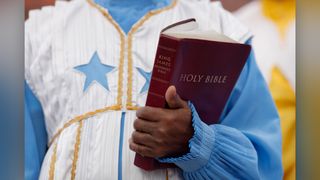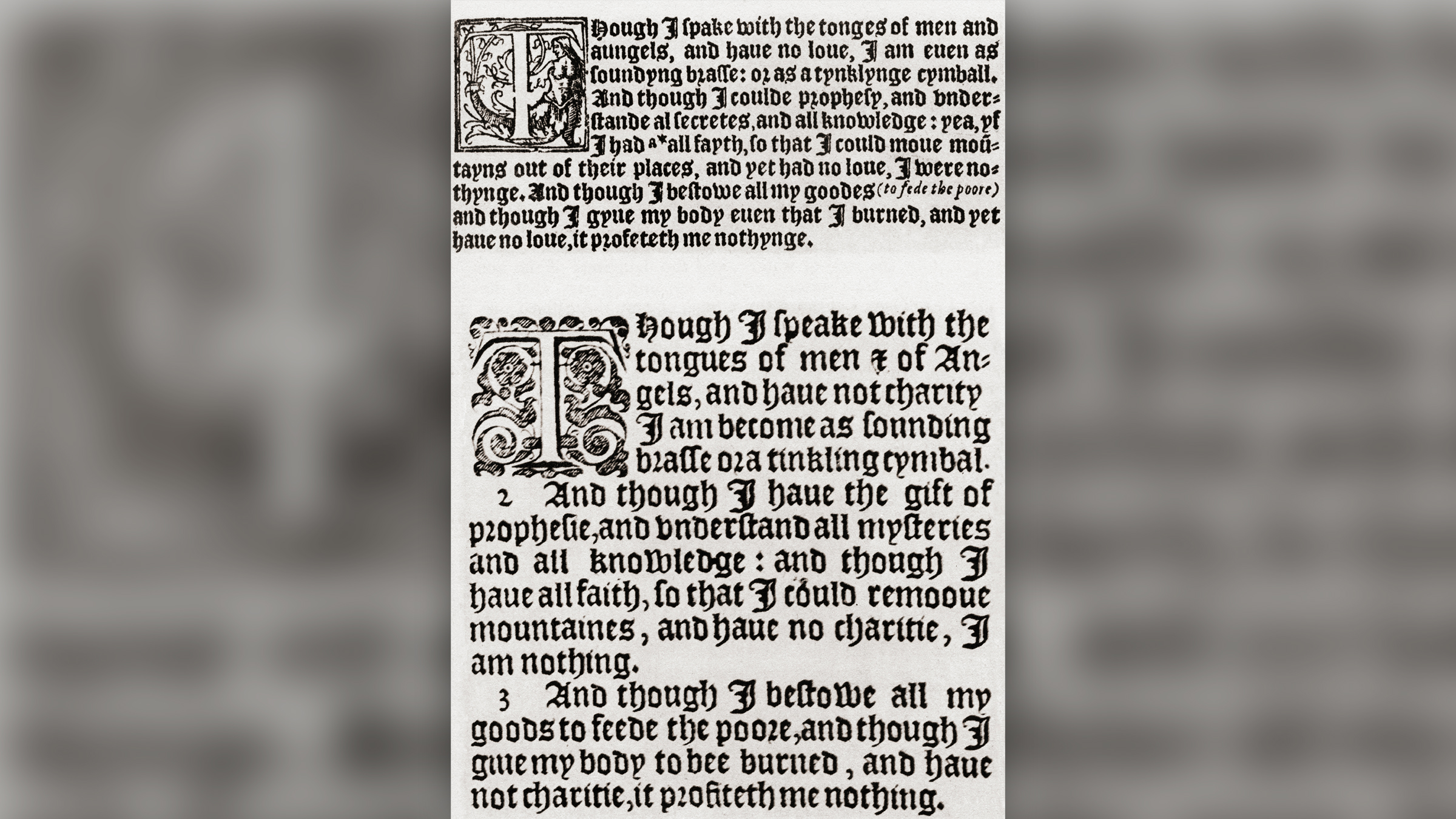Bible Scriptures to Read When You're Asking God for Something From King James Version
Why is the King James Bible and then popular?

Shortly after he ascended the English throne in 1603, Rex James I commissioned a new Holy Bible translation that, more than than 400 years later, is nevertheless widely read around the world.
This Bible, known as the King James Version (KJV), helped King James exit behind a lasting cultural footprint — one of his goals equally a leader. "James saw himself as a great Renaissance figure who wanted to impart on the world culture, music, literature and fifty-fifty new ways of learning," Bruce Gordon, a professor of ecclesiastical history at Yale Divinity School, told Live Science.
Simply given the KJV'south historic period, why is it nonetheless so pop across different Christian denominations?
Related: Why does Christianity have so many denominations?
In curt, the KJV'south influence has waxed over the centuries because, Gordon said, information technology was the version that was almost widely read and distributed in countries where English was the dominant linguistic communication and that its translation was "never really challenged until the 20th century." In that time, the KJV became so embedded in the Anglo-American world that "many people in Africa and Asia were taught English language from the KJV" when Christian missionaries brought information technology to them, Gordon said. "Many people weren't even aware that it was one of many bachelor translations," he added, "they believed the King James Version was the Bible in English."
But there's more to the story that goes back to the translation's inception.
Why did Rex James want a newly translated Bible?
Before James commissioned the KJV in 1604, nearly people in England were learning from two unlike Bibles — the Church of England's translation, commonly read during worship services (known as the Bishops' Bible, first published in 1568), and the more popular version most Brits read at home, known equally the Geneva Bible, starting time published in 1560. The Geneva Bible was the Bible of choice among Protestants and Protestant sects, and as a Presbyterian, James also read that version. Notwithstanding, he disliked the lengthy and distracting annotations in the margins, some of which even questioned the power of a king, co-ordinate to Gordon.
What's more, when James assumed the English throne in March 1603, following the death of Queen Elizabeth I, he inherited a complicated political situation, as the Puritans and the Calvinists — religious followers of reformer John Calvin — were openly questioning the absolute power of the Church of England's bishops. James' own mother — Mary, Queen of Scots — had been executed 16 years earlier in part because she was perceived to be a Catholic threat to Queen Elizabeth'south Protestant reign. "Mary's death made James keenly enlightened of how hands he could be removed if he upset the wrong people," Gordon said.

To moderate such divisions, James commissioned a Bible that aimed to please both parishioners of the Church building of England and the growing Protestant sects by removing the problematic and unpopular annotations of the Geneva Bible while remaining true to the manner and translations from both Bibles that each grouping revered. Despite James' efforts, Gordon said, "the KJV didn't really succeed while James was alive." That'due south because the market for James' version didn't really arise until the 1640s, when Archbishop William Laud, who "hated the Puritans," suppressed the Geneva Bible that the Puritans followed, Gordon said.
James died from a stroke in March 1625, so he never saw his Bible go widely accustomed. But even during his lifetime, after James commissioned the translation, he didn't oversee the process himself. "Information technology's nearly equally if he got the ball rolling, then washed his easily of the whole thing," Gordon said.
Related: Was the 'forbidden fruit' in the Garden of Eden really an apple?
How the KJV was translated
To oversee the translation, James commissioned half-dozen committees made upward of 47 scholars from the universities of Oxford and Cambridge. They were tasked with translating all of the Hebrew and Greek texts of the Old and New Testaments into English. Information technology was a complicated and sometimes contentious procedure that took seven years to consummate. Though nosotros don't have a lot of the records of those committees, "through our best reconstructions, we understand it was a very rigorous debate with anybody committed to the most accurate translation of the Bible," Gordon said.
Much of the resulting translation drew on the work of William Tyndale, a Protestant reformer who had produced the start New Testament translation from Greek to English in 1525. "It's believed that upwardly to 80% of the King James Version stems from the William Tyndale version," Gordon said.

Why is the KJV all the same pop today?
For a book that was published in 1611, it's amazing how influential and widely read the KJV withal is today. Though there are hundreds of versions and translations of the Bible, the KJV is the nearly popular. According to market research firm Statistica, as of 2017, more than 31% of Americans read the KJV, with the New International Version coming in 2d place, at 13%. V large denominations of Christianity — Baptist, Episcopalian, Presbyterian, Latter-twenty-four hour period Saints and Pentecostal — use the KJV today.
The KJV "works as both a word-for-word and sense-for-sense translation," meaning it acts every bit both a literal translation of many of the words believed to have been used by Jesus Christ and his Apostles and accurately conveys the meaning behind those words and events, Gordon said. One line of manuscripts used in the KJV — the Textus Receptus of Erasmus, translated from Greek to Latin by the 16th-century Dutch scholar and philosopher Desiderius Erasmus — is idea past some to be a particularly important inclusion in the KJV, particularly for those who come across information technology as the purest line of the New Testament going back to the Apostolic Age (A.D. 33 to 100), Gordon said.
Despite the KJV'due south popularity throughout the centuries, Gordon said some scholars at present view parts of it every bit outdated. He cautioned that at that place have been other ancient manuscripts discovered since the KJV was deputed that heighten scholars' understanding of some biblical events and possibly even change the pregnant of certain words.
Related: What led to the emergence of monotheism?
For example, in the mid-20th century, "many translators believed that 'maiden' or 'young woman' was a more than authentic Hebraic translation to use to describe Jesus' mother Mary, instead of 'virgin,'" Gordon said. If correct, the estimation would have far-reaching implications as the Onetime Attestation prophet Isaiah had prophesied that the Messiah would exist born of a virgin. "Translations," Gordon said, "are not neutral things."
To that terminate, many KJV readers (known as "King James Onlyists") don't believe the Bible should be updated at all and hold to the notion that James' version was translated from the almost reliable manuscripts. What'due south more than, Gordon said, some Onlyists believe that the scholars who oversaw the KJV translation were "divinely inspired" and that more mod translations should be disregarded considering they accept been "carried out past nonbelievers."
Even casual religious observers or nonbelievers are affected by the prose of the KJV Bible in ways they may not realize. Its poetic language has influenced generations of artists and activists, with many biblical phrases becoming part of our everyday language. A few examples include "the blind leading the blind," "the powers that be," "my brother'south keeper," "past the skin of your teeth," "a wolf in sheep's article of clothing," "rise and smoothen" and "go the extra mile," according to Wide Open Country. Fifty-fifty the famous opening line "Four score and seven years ago" from President Abraham Lincoln's Gettysburg Address was inspired by language used in the KJV.
Originally published on Live Science.
Source: https://www.livescience.com/why-king-james-bible.html

0 Response to "Bible Scriptures to Read When You're Asking God for Something From King James Version"
Post a Comment